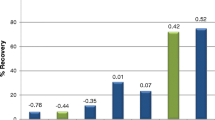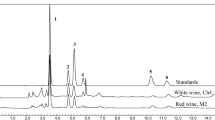Abstract
A rapid and reliable method based on liquid chromatography with UV detection has been developed here to determine the main organic acids in base and sparkling wines of the protected designation of origin Cava. Compounds have been separated by reversed-phase mode with a water/acetonitrile solution (95:5 v/v adjusted to pH 2). Figures of merit established at 210 nm are fully compatible with the wine analysis, with correlation coefficients better than 0.996, repeatabilities around 2%, and detection limits generally below 1 g L−1. A total of 53 base wine and 140 cava samples from different coupages have been analyzed. Compositional profiles of organic acids have been used as the source of analytical information for characterization and classification purposes. Results have shown that varietal and blending issues, malolactic fermentation, and tartaric acid stabilization affect the composition of organic acids.





Similar content being viewed by others
References
Buxaderas S, Lopez-Tamames E (2012) Sparkling wines: features and trends from tradition. In: Henry J (ed) Book Series: Advances in Food and Nutrition Research, vol 66, pp 1–45
Chidi BS, Rossouw D, Buica AS, Bauer FF (2015) Determining the impact of industrial wine yeast strains on organic acid production under white and red wine-like fermentation conditions. S Afr J Enol Vitic 36:316
Chidi BS, Bauer FF, Rossouw D (2018) Organic acid metabolism and the impact of fermentation practices on wine acidity - a review. S Afr J Enol Vitic 39:315
Coelho EM, Padilha CVD, Miskinis GA, de So AGB, Pereira GE, de Azevedo LC, Lima MD (2018) Simultaneous analysis of sugars and organic acids in wine and grape juices by HPLC: method validation and characterization of products from northeast Brazil. J Food Compos Anal 66:160–167
de Souza JC, da Silva JL, Fabrao RM, Stradiotto NR, Zanoni MVB (2019) Electroactive sugars, organic acids and sugar alcohol analysis in wine using anion-exchange chromatography with electrochemical detection. Microchem J 147:972–978. https://doi.org/10.1016/j.microc.2019.04.010
http://www.institutdelcava.com/en/ (accessed 24th January, 2020).
Ivanova-Petropulos V, Petruseva D, Mitrev S (2020) Rapid and simple method for determination of target organic acids in wine using HPLC-DAD analysis. Food Anal Methods 13:1078–1087. https://doi.org/10.1007/s12161-020-01724-4
Izquierdo-Llopart A, Saurina J (2019) Characterization of sparkling wines according to polyphenolic profiles obtained by HPLC-UV/Vis and principal component analysis. Foods 8:22
Kerem Z, Bravdo BA, Shoseyov O, Tugendhaft Y (2004) Rapid liquid chromatography-ultraviolet determination of organic acids and phenolic compounds in red wine and must. J Chromatogr A 1052:211–215
Kritsunankul O, Pramote B, Jakmunee J (2009) Flow injection on-line dialysis coupled to high performance liquid chromatography for the determination of some organic acids in wine. Talanta 79:1042–1049
Li FF, Bao Y, Yu YX, Cui H, Fa Y, Liu H (2018) Simultaneous determination of organic acids, inorganic anions, and alditols in wine with valve-switching ion chromatography. Chromatographia 81:1103–1108
Lima MD, Nunes PC, Silva BDD, Padilha CVD, do Bonfim THF, Stamford TLM, Vasconcelos MAD, Aquino JD (2019) Determining 1-kestose, nystose and raffinose oligosaccharides in grape juices and wines using HPLC: method validation and characterization of products from Northeast Brazil. J Food Sci Technol 56:4575–4584. https://doi.org/10.1007/s13197-019-03936-x
Long WJ, Brooks AE, Biazzo W (2009) Analysis of polar compounds using 100% aqueous mobile phases with Agilent ZORBAX Eclipse Plus Phenyl-Hexyl and other ZORBAX Phenyl Columns. Application note. Agilent Technologies Inc., Santa Clara, CA, USA, pp. 1-7. Available at https://www.agilent.com/cs/library/applications/5990-3616EN.pdf.
Maicas S (2001) The use of alternative technologies to develop malolactic fermentation in wine. Appl Microbiol Biotechnol 56:35
Mataix E, Luque de Castro MD (2001) Determination of L-(-)-malic acid and L-(+)-lactic acid in wine by a flow injection-dialysis-enzymic derivatisation approach. Anal Chim Acta 428:7–14
Mato I, Suarez-Luque S, Huidobro JF (2005) A review of the analytical methods to determine organic acids in grape juices and wines. Food Res Int 38:1175–1188
Mato I, Suarez-Luque S, Huidobro JF (2007) Simple determination of main organic acids in grape juice and wine by using capillary zone electrophoresis with direct UV detection. Food Chem 102:104–112
Mazzei F, Botre F, Favero G (2007) Peroxidase based biosensors for the selective determination of D,L-lactic acid and L-malic acid in wines. Microchem J 87:81–86
Monosik R, Stred’ansky M, Greif G, Sturdik E (2012) Comparison of biosensors based on gold and nanocomposite electrodes for monitoring of malic acid in wine. Cent Eur J Chem 10:157
Ohira SI, Kuhara K, Shigetomi A, Yamasaki T, Kodama Y, Dasgupta PK, Toda K (2014) On-line electrodialytic matrix isolation for chromatographic determination of organic acids in wine. J Chromatogr A 1372:18–24
Palmer JK, Lis DM (1973) Determination of organic acids in foods by liquid chromatography. J Agric Food Chem 21:903–906
Pereira V, Camara JS, Cacho J, Marques JC (2010) HPLC-DAD methodology for the quantification of organic acids, furans and polyphenols by direct injection of wine samples. J Sep Sci 33:1204–1215. https://doi.org/10.1002/jssc.200900784
Peres RG, Moraes EP, Micke GA, Tonin FG, Tavares MFM, Rodriguez-Amaya DB (2009) Rapid method for the determination of organic acids in wine by capillary electrophoresis with indirect UV detection. Food Control 20:548–552
Pizarro C, Gonzalez-Saiz JM, Esteban-Diez I, Orio P (2011) Prediction of total and volatile acidity in red wines by Fourier-transform mid-infrared spectroscopy and iterative predictor weighting. Anal Bioanal Chem 399:2061–2072
Ragone R, Crupi P, Piccinonna S, Bergamini C, Mazzone F, Fanizzi FP, Schena FP, Antonacci D (2015) Classification and chemometric study of Southern Italy monovarietal wines based on NMR and HPLC-DAD-MS. Food Sci Biotechnol 24:817–826
Regmi U, Palma M, Barroso CG (2012) Direct determination of organic acids in wine and wine-derived products by Fourier transform infrared (FT-IR) spectroscopy and chemometric techniques. Anal Chim Acta 732:137–144
Ricciutelli M, Moretti S, Galarini R, Sagratini G, Mari M, Lucarini S, Vittori S, Caprioli G (2019) Identification and quantification of new isomers of isopropyl-malic acid in wine by LC-IT and LC-Q-Orbitrap. Food Chem 294:390–396. https://doi.org/10.1016/j.foodchem.2019.05.068F
Rovio S, Siren K, Siren H (2011) Application of capillary electrophoresis to determine metal cations, anions, organic acids, and carbohydrates in some Pinot Noir red wines. Food Chem 124:1194–1200
Saurina J (2010) Characterization of wines using compositional profiles and chemometrics. Trends Anal Chem 29:234–245
Snow L, Trass M, Klein M, Orlowicz S, Rivera B (2015) Fast and robust analysis of organic acids from wine using HPLC-UV. Application note TN-1189, pp.1-8. Phenomenex, Torrance, CA, USA. Available at https://az621941.vo.msecnd.net/documents/0d4a0bb0-f83c-4a26-b928-43649c3ed58a.pdf.
Sochorova L, Torokova L, Baron M, Sochor J (2018) Electrochemical and others techniques for the determination of malic acid and tartaric acid in must and wine. Int J Electrochem Sci 13:9145
Sweetman C, Deluc LG, Cramer GR, Ford CM, Soole KL (2009) Regulation of malate metabolism in grape berry and other developing fruits. Phytochemistry 70:1329–1344
Tasev K, Stefova M, Ivanova-Petropulos V (2016) HPLC method validation and application for organic acid analysis in wine after solid-phase extraction. Maced J Chem Chem Eng 35:225–233. https://doi.org/10.20450/mjcce.2016.1073
Versari A, Parpinello GP, Cattaneo M (1999) Leuconostoc oenos and malolactic fermentation in wine: a review. J Ind Microbiol Biotechnol 23:447–455
Zeravik J, Fohlerova Z, Milovanovic M, Kubesa O, Zeisbergerova M, Lacina K, Petrovic A, Glatz Z, Skladal P (2016) Various instrumental approaches for determination of organic acids in wines. Food Chem 194:432–440
Zhang XK, Lan YB, Zhu BQ, Xiang XF, Duan CQ, Shi Y (2018) Changes in monosaccharides, organic acids and amino acids during Cabernet Sauvignon wine ageing based on a simultaneous analysis using gas chromatography-mass spectrometry. J Sci Food Agric 98:104–112
Zheng YJ, Duan YT, Zhang YF, Pan QH, Li JM, Huang WD (2009) Determination of organic acids in red wine and must on only one RP-LC-column directly after sample dilution and filtration. Chromatographia 69:1391–1395
Zotou A, Loukou Z, Karava O (2004) Method development for the determination of seven organic acids in wines by reversed-phase high performance liquid chromatography. Chromatographia 60:39–44. https://doi.org/10.1365/s10337-004-0330-9
Acknowledgments
The authors thank Raventós Codorníu SA for kindly providing the cava samples.
Author information
Authors and Affiliations
Corresponding author
Ethics declarations
Conflict of Interest
Anaïs Izquierdo Llopart declares that she has no conflict of interest. Aida Carretero declares that she has no conflict of interest. Javier Saurina declares that he has no conflict of interest.
Ethical Approval
This article does not contain any studies with humans and animals performed by any of the authors.
Informed Consent
Not applicable.
Additional information
Publisher’s Note
Springer Nature remains neutral with regard to jurisdictional claims in published maps and institutional affiliations.
Rights and permissions
About this article
Cite this article
Izquierdo-Llopart, A., Carretero, A. & Saurina, J. Organic Acid Profiling by Liquid Chromatography for the Characterization of Base Vines and Sparkling Wines. Food Anal. Methods 13, 1852–1866 (2020). https://doi.org/10.1007/s12161-020-01808-1
Received:
Accepted:
Published:
Issue Date:
DOI: https://doi.org/10.1007/s12161-020-01808-1




